ASE’s Medieval Garden | 4 | Flowers
16 December 2021
In the last blog in the Medieval Garden series Lorna is exploring the beautiful world of flowers, their uses and in some cases their symbolism.
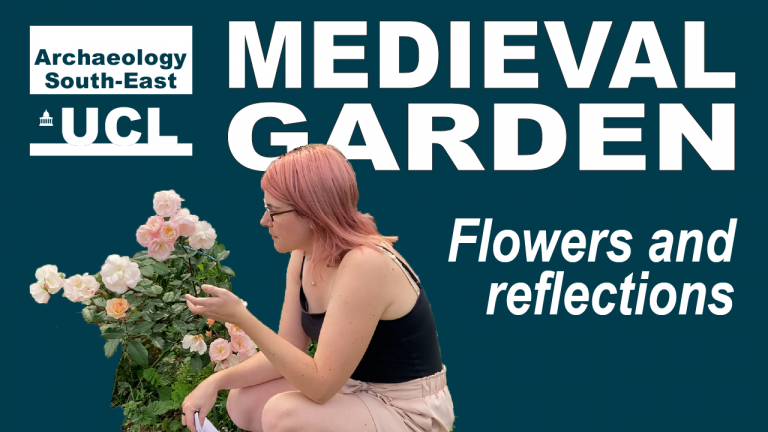
Introduction
How and where we have grown flowers has changed over the centuries. The growing of food produce has been a priority right from the earliest known gardens, but even so it seems that flowers have been grown in beside vegetables for centuries.
In the medieval period flowers were used for multiple purposes including home decoration, all year round in garlands and wreaths (McLean 1980). Other uses include clothing and hair adornment, gifts for others as well as being eaten with meals and in medicinal recipes.
There are many flowers that are found depicted in manuscript evidence, carvings and described in text. We are going to look at four that are well known today and still can be found in our gardens and allotments.
Nasturtium
Þane a mannes fex sealle genim þæne þynte reap þe man nasturcium y oþnum naman cænre nemneth do on þa nora a fex sceal pexan.
---In case a man’s hair falls out, take the juice of the plant called nasturtium or water cress and put it up the nose to induce hair growth.
This entry from the Old English Herbarium illustrates a cure for hair loss using Nasturtiums. Even though I’m not convinced they work as a cure for hair loss, Nasturtiums are a fantastic plant to have on the allotment and in the garden. As a member of the cabbage family, Nasturtiums are edible plants which can be used like watercress. In the modern world they are used to garnish salads and they have a peppery taste.
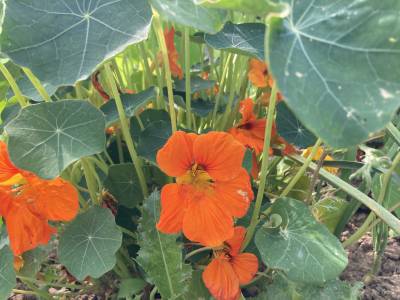
Nasturtiums
Pot Marigold
Calendula officinalis, better known as Pot Marigold, is a bright yellow or orange flowering plant. It is very easy to grow and is a common sight as it easily escapes from gardens and allotments and can sometimes be found along roadsides. Pot Marigold is a fantastic pollinator and it is edible for humans. With its bright petals it can be used in lieu of saffron and is sometimes called “poor man’s saffron” because of this. In the 10th century text the Lacnunga it is used in a green salve, with is a mixture of lots of plants for general health ailments.
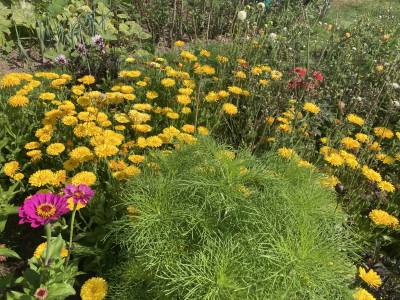
Pot Marigold
Poppies
Famous for their sedative properties, poppies have been used for centuries for pain relief and as a sedative. Ancient Egyptian doctors would have their patients eat seeds from a poppy to relieve pain. They are seen as symbols for the dead, with their link to sleeping and are found on tombstones dating back to the Roman period. This association with eternal sleeping and death continues on to the modern day with the poppy being a symbol of remembrance for service men and women lost in warfare.
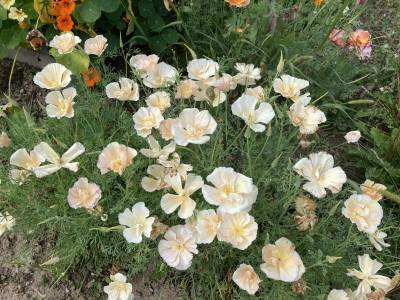
Poppies
This association with the poppy being a sedative is demonstrated in the Leechbook and in the Old English Herbarium (Cotton MS Vitellius C III fol.). One recipe reads like this:
Þiþ slæplearte genym þyrre ylcan þyrte þor fmyre þone man mid rona þu him þone slep onsenft.
---For sleeplessness, take ooze of poppy, smear the man with it; and soon it will send the sleep on him.
Rose
A common sight in many gardens, roses are the emblem of a traditional English garden with their elegant form and beautiful scent. Roses have featured throughout history but it is during the medieval period where their symbolism became really pronounced.
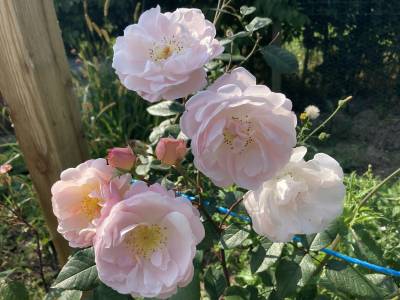
Roses
The Rose becomes a political symbol by the end of the medieval period as the two branches of the house of Plantagenet use the white rose and the red rose as their symbols in the Wars of the Roses. This is then combined by Henry VII to create the Tudor Rose during his reign.
Roses are also used as a religious symbol usually associated with the Virgin Mary and by the 12th century, they were cultivated in monastery gardens with the red rose being a representation of Christ’s passion. This is highlighted in the mystic rose mentioned in the Christmas carol “There is no rose” which uses the imagery to describe the Virgin Mary and Christ’s passion through the red of his blood almost simultaneously. The association with roses and purity and virginity is a trope still visible in modern times.
Conclusions
Flowers in general are seen as complicated entities. They are both beautiful and useful, whimsical and symbolic. They are often seen as romantic and are present in milestone moments in life such as birthdays, achievements, marriages and in times of difficulty. This seems to have been the case throughout the Middle Ages as it is today, as well as the medicinal properties and of course the gardener’s advantages of flowers being attractive things for both humans and insects!
Make sure you watch the last video in the series to hear how making ASE’s Medieval Garden has benefitted me as an archaeologist, medieval historian, and a gardener!
References
McLean, T, 1980 Medieval English Gardens. Viking Press: New York.
External Links
The British library has a fantastic collection of digitised manuscripts including:
Bald’s Leechbook http://www.bl.uk/manuscripts/Viewer.aspx?ref=royal_ms_12_d_xvii_fs001ar
The Lacnunga http://www.bl.uk/manuscripts/Viewer.aspx?ref=harley_ms_585_f001r
The Old English Herbal http://www.bl.uk/manuscripts/Viewer.aspx?ref=cotton_ms_vitellius_c_iii_f011r
The RHS has a list of more edible plants here: https://www.rhs.org.uk/herbs/edible-flowers
 Close
Close

